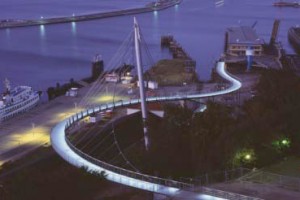
Pedestrian bridges are special structures. Distinct from street or railway bridges, they should be both functional and visually interesting. Footbridge designers are often asked to create a contextualized, unique, beautiful structure considering the human scale of the users. It must have its own identity, fashioned from its locale, materials, structural technique and form. The diverse environs surrounding footbridges, and the challenges they present, have prompted designs which utilize the curvature in the structural plan as the defining characteristic of their architectural aesthetic. To keep curved pedestrian bridge designs progressive, it is essential to understand how one can transform the principles of engineering used for straight bridges; even more important is to exploit the benefits of curvature and arrange the structural elements accordingly. This innovation is particularly important now, when computers are ever more capable of calculating every type of structure. The lecture will focus on the design of cable-supported, curved footbridges, the principles behind their design, form-finding of cable geometry and advantages to their layout. These aspects will be illustrated using examples of finished projects – with lengths up to 200m – which were created by our offices.Schlaich Bergermann and Partner, with offices in Stuttgart, Berlin and New York City, have designed major bridges around the world, including unique footbridges in Europe and North America. Many projects have received awards for outstanding bridge design – like the 2006 OCEA from the ASCE, and the Arthur H. Hayden Medal from the ESWP for the (curved) Liberty Bridge in Greenville, South Carolina.
Michael Stein
Managing Director
Schlaich Bergermann and Partner LP, New York